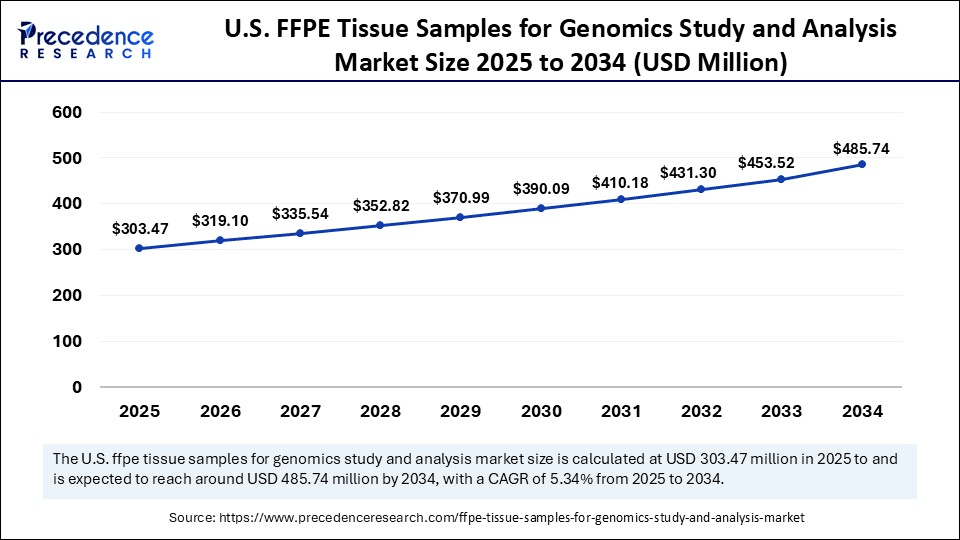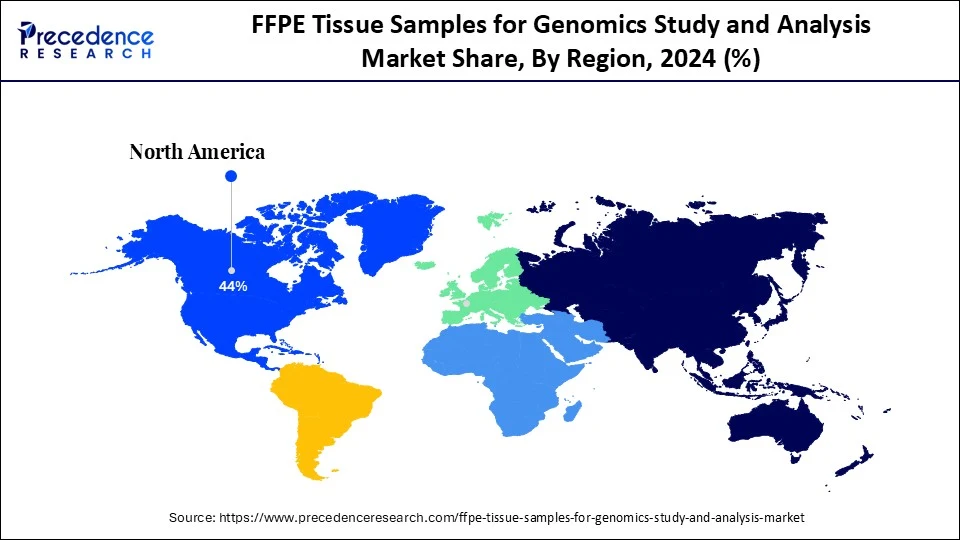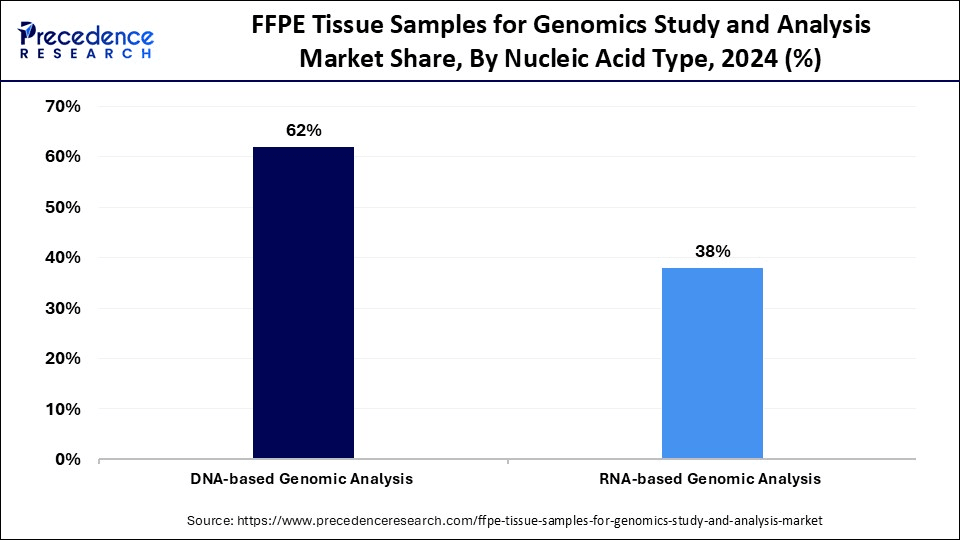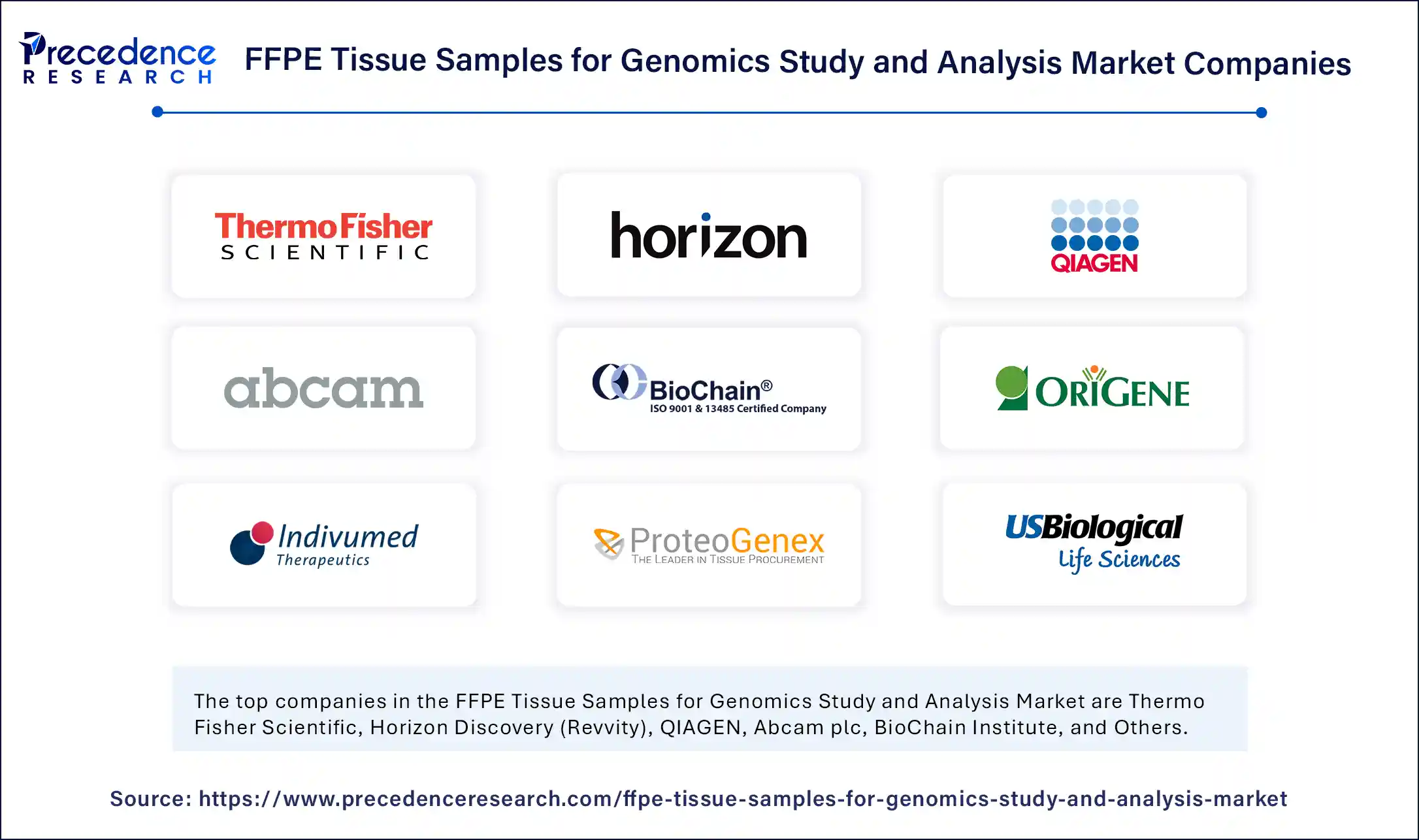List of Contents
FFPE Tissue Samples for Genomics Study and Analysis Market Size and Forecast 2025 to 2034
The global FFPE tissue samples for genomics study and analysis market size accounted for USD 937.04 million in 2024 and is predicted to increase from USD 985.3 million in 2025 to approximately USD 1,548.29 million by 2034, expanding at a CAGR of 5.15% from 2025 to 2034. The market is rapidly expanding due to a heightened focus on genomics and precision medicine, leading to the increased demand for FFPE (formalin-fixed paraffin-embedded) tissue samples. These samples are crucial for biomarker discovery and retrospective studies. Additionally, the growing adoption of next-generation sequencing (NGS) and the need for standardized preserved samples are contributing to market expansion.

FFPE Tissue Samples for Genomics Study and Analysis MarketKey Takeaways
- In terms of revenue, the global FFPE tissue samples for genomics study and analysis market was valued at USD 937.04 million in 2024.
- It is projected to reach USD 1,548.29 million by 2034.
- The market is expected to grow at a CAGR of 5.15% from 2025 to 2034.
- North America dominated the FFPE tissue samples for genomics study and analysis market with the largest market share of 44% in 2024.
- Asia Pacific is expected to grow at the fastest CAGR from 2025 to 2034.
- By sample type, the blocks segment held the biggest market share of 38% in 2024.
- By sample type, the sections segment is expected to grow at a significant CAGR over the projected period.
- By nucleic acid type, the DNA-based genomic analysis segment generated the major market share of 62% in 2024.
- By nucleic acid type, the RNA-based genomic analysis segment is projected to grow at the highest CAGR between 2025 and 2034.
- By technology, the next-generation sequencing (NGS) segment contributed the biggest market share of 55% in 2024.
- By technology, the digital PCR (dPCR) segment is expected to expand at a significant CAGR from 2025 to 2034.
- By application, the cancer genomics segment captured the largest market share of 48% in 2024.
- By application, the pharmacogenomics segment is anticipated to grow at a significant CAGR from 2025 to 2034.
- By end user, the academic and research institutes segment accounted for major market share of 33% in 2024.
- By end user, the biopharmaceutical and biotechnology companies segment is expected to grow at the fastest CAGR over the projected period.
How Does AI Influence the FFPE Tissue Samples for Genomics Study and Analysis Market?
Artificial intelligenceis transforming the market for FFPE tissue samples for genomics study and analysis by enabling researchers to analyze large amounts of data and extract valuable insights from archived tissue samples, ultimately accelerating drug discovery and personalized medicine. AI algorithms can analyze FFPE samples, which are routinely stored in hospitals, to identify DNA mutations and other genomic alterations, providing a wealth of information for cancer research. AI helps handle the complexities of FFPE samples, such as DNA degradation, and processes large datasets generated by next-generation sequencing.
- In May 2024, a research team from Pennsylvania State University developed an AI model called EXpression PREdiction with Summary Statistics Only (EXPRESSO) to gain insight into how gene expression impacts autoimmune disease risk. The tool is designed to incorporate single-cell expression quantitative trait loci, 3D genomic data, and epigenetics to model how autoimmune disease-associated genes are expressed and regulated. This information can then be used to flag additional risk genes and improve therapies.
(Source: https://www.techtarget.com)
U.S. FFPE Tissue Samples for Genomics Study and Analysis Market Size and Growth 2025 to 2034
The U.S. FFPE tissue samples for genomics study and analysis market size was exhibited at USD 288.61 million in 2024 and is projected to be worth around USD 485.74 million by 2034, growing at a CAGR of 5.34% from 2025 to 2034.

What Made North America the Dominant Region in the FFPE Tissue Samples for Genomics Study and Analysis Market in 2024?
North America dominated the market by capturing a 44% share in 2024, primarily due to its strong research infrastructure, significant government funding, and widespread adoption of precision medicine. The region's advanced healthcare system, with well-equipped research facilities and hospitals, supports the collection, processing, and analysis of FFPE samples. The U.S. government invests heavily in biomedical research, including genomics and personalized medicine, which increases demand for FFPE tissue samples. Ongoing innovations in genomic technologies, like next-generation sequencing, improve the reliability and ease of analyzing FFPE samples, further increasing their use.
U.S. FFPE Tissue Samples for Genomics Study and Analysis Market Trends
The U.S. plays a key role in the global market. This is mainly due to the widespread use of electronic health records (EHRs), personalized medicine, government programs supporting population health management, and the presence of many leading biotech and genomics research organizations. U.S. institutions are at the forefront of developing advanced techniques for analyzing FFPE samples, including spatial genomics and transcriptomics. Furthermore, companies like 10x Genomics are developing and commercializing technologies that improve nucleic acid extraction, preservation, and analysis from FFPE samples.
- In March 2024, 10x Genomics, a U.S.-based life science technology company, started commercial shipping of its long-awaited Visium HD Spatial Gene Expression instrument, a next-generation version of its Visium spatial biology tool. Visium HD is designed to allow comprehensive analysis of FFPE tissue sections by measuring whole transcriptome spatial gene expression at single-cell resolution.
(Source: https://www.genengnews.com)

What Makes Asia Pacific the Fastest-Growing Region in the FFPE Tissue Samples for Genomics Study and Analysis Market?
Asia Pacific is expected to experience the fastest growth in the market. This growth is primarily driven by the increasing prevalence of cancer, rising awareness of genomics, and significant government investments in healthcare and research. Advances in genome sequencing technologies are making it easier and more affordable to analyze FFPE tissue samples, further accelerating market growth. Governments in countries such as China, India, and South Korea are heavily investing in healthcare infrastructure, genomics research, and personalized medicine programs, creating a favorable environment for the FFPE tissue market. Additionally, government initiatives and collaborations are promoting the development and adoption of innovative genomic technologies, including those that utilize FFPE tissue samples.
China FFPE Tissue Samples for Genomics Study and Analysis Market Trends
China plays a key role as both a consumer and a potential producer of FFPE samples. With its large population and increasing investments in healthcare and research, the demand for FFPE tissues for genomic studies in China is rising. The availability of archived FFPE samples, combined with advancements in genomic technologies, positions China as a significant player in research and development within this field. China's growing expertise in genomics and biotechnology may lead to the creation of innovative methods for analyzing FFPE samples and extracting high-quality genomic data.
Why is Europe Considered a Significant Player in the FFPE Tissue Samples for Genomics Study and Analysis Market?
Europe is considered to be a significantly growing area. The market in the region is expected to grow at a considerable rate due to its strong healthcare infrastructure, a robust research ecosystem, increasing investments in genomics, and a rising prevalence of chronic diseases. Europe is actively pursuing digital transformation in healthcare, with initiatives such as digital pathology platforms that utilize artificial intelligence for faster and more accurate analysis of FFPE samples. Countries like Germany, the UK, and France are leading in medical research, encouraging innovation and collaboration in genomics. France has launched national genomic medicine initiatives aimed at integrating genomics into clinical practice to improve diagnostics and treatment. Furthermore, the presence of prominent companies such as BioChain Institute, Amsbio, Cureline, and Discovery Life Sciences is driving market growth.
- In March 2025, the Federated European Genome-phenome Archive (FEGA) expanded its network, enhancing the sharing and access of sensitive human genomic data. Building on the framework of the European Genome-phenome Archive (EGA), FEGA enables researchers to securely discover and analyze genomic data while complying with data protection regulations. This ensures security within the country of origin while allowing global access for researchers.
(Source: https://www.embl.org)
What Opportunities Exist in the FFPE Tissue Samples for Genomics Study and Analysis Market Within Latin America?
The market in Latin America is expected to grow at a steady rate, largely due to the rising incidence of cancer and rising demand for personalized medicine. According to the National Institutes of Health (NIH), an estimated 1.5 million new cancer cases and 700,000 deaths occur annually in Latin America, prompting the need for targeted therapies. There is a strong focus on strengthening local manufacturing of vaccines, including mRNA vaccines. Initiatives like the PAHO's Special Program on Innovation and the Regional Production Platform are promoting regional cooperation to boost local production and decrease reliance on imports. Governments in Latin American countries are increasingly acknowledging the significance of research and development in genomics and are providing support for local research initiatives and collaborations.
(Source: https://pmc.ncbi.nlm.nih.gov)
What are the Key Factors Driving the Growth of the FFPE Tissue Samples for Genomics Study and Analysis Market in the Middle East and Africa?
The growth of the market within the Middle East and Africa is driven by the increasing demand for genetic testing, particularly for cancer and inherited diseases, as well as rising investments in population-specific genomic programs. Several countries in the region are launching genome programs tailored to their populations to enhance genetic diagnostics and facilitate the advancement of precision medicine. Initiatives are also focusing on promoting ethical and equitable practices in genomic research to ensure that the benefits of these advancements are fairly distributed across populations. A notable initiative funded by the NIH and Wellcome Trust, H3Africa, is working to build capacity and infrastructure for genomic research in Africa while fostering collaboration among African scientists.
Market Overview
The FFPE (Formalin-Fixed Paraffin-Embedded) tissue samples for genomics study and analysis market refer to the global industry involved in collecting, processing, preserving, storing, distributing, and conducting downstream analysis of FFPE tissue specimens, specifically used for genomic applications. These samples, commonly derived from biopsies or surgical procedures, undergo formalin fixation and paraffin embedding to maintain morphological integrity and molecular stability. In genomics, FFPE tissues are widely utilized for DNA/RNA extraction, next-generation sequencing (NGS), transcriptomics, epigenomics, biomarker discovery, and personalized medicine research. The market includes suppliers of FFPE blocks/slides, service providers for extraction and sequencing, and biobanks offering archived samples with annotated clinical data. The growth of the market is driven by the need for accurate diagnosis, personalized treatment strategies, and the development of new therapies.
What are the key Trends in the FFPE Tissue Samples for Genomics Study and Analysis Market?
- Increased Demand for Tissue Processing: The increasing workload of histopathologists and the complexity of medical cases, with the necessity for faster and more efficient tissue analysis, drive the demand for advanced tissue processing techniques, which are crucial for FFPE sample preparation, boosting the market.
- Growing Biobanking Infrastructure: The expansion of biobanking facilities storing FFPE samples provides a valuable resource for researchers, facilitating large-scale genomic studies and retrospective analyses, further supporting market growth.
- Expansion of Proteomic Studies: FFPE tissue samples are also valuable for proteomic analysis, allowing researchers to study protein expression patterns and identify potential drug targets. Additionally, greater investment in proteomic research is further attributed to the demand for high-quality tissue samples.
- Advancements in Genomic Technologies: Developments in DNA sequencing, RNA sequencing technologies, and bioinformatics tools have enhanced the ability to extract and analyze valuable genomic information from FFPE samples, enabling more detailed genomic and proteomic studies and driving their adoption in research.
Market Scope
| Report Coverage | Details |
| Market Size by 2034 | USD 1,548.29 Million |
| Market Size in 2025 | USD 985.3 Million |
| Market Size in 2024 | USD 937.04 Million |
| Market Growth Rate from 2025 to 2034 | CAGR of 5.15% |
| Dominating Region | North America |
| Fastest Growing Region | Asia Pacific |
| Base Year | 2024 |
| Forecast Period | 2025 to 2034 |
| Segments Covered | Sample Type, Nucleic Acid Type, Technology, Application, End Userand Region |
| Regions Covered | North America, Europe, Asia-Pacific, Latin America, and Middle East & Africa |
Market Dynamics
Drivers
Increasing Prevalence of Cancer and the Increasing Demand for Personalized Medicine
The primary drivers of the FFPE tissue samples for genomics study and analysis market are the rising prevalence of cancer and the increasing demand for personalized medicine. This is further supported by advancements in genomic sequencing technologies that enable detailed genomic profiling from these preserved samples. Cancer remains a leading cause of death worldwide, and the need for effective diagnostic and therapeutic strategies is continuously growing. FFPE samples, often collected during biopsies or surgical procedures, are valuable resources for researchers investigating cancer genomics and developing new treatment approaches. Genomic analysis of these samples helps identify biomarkers and genetic mutations that assists in treatment decisions and predict patient response to therapies. Additionally, FFPE samples, with their preserved nucleic acids, provide a means to analyze DNA and RNA for identifying biomarkers and predicting treatment response.
Restrain
Concern About Damage to Nucleic Acids Caused by Formalin Fixation
The primary challenge in the FFPE tissue samples for genomics study and analysis market is the concern about damage to nucleic acids (DNA and RNA) caused by formalin fixation. This damage, including fragmentation and chemical modifications, can hinder the accuracy and reliability of genomic analyses. These changes can interfere with DNA amplification and sequencing, potentially leading to inaccurate variant detection. These issues can reduce the yield of amplifiable DNA and RNA from FFPE samples, affecting the success rate of genomic assays like whole-genome sequencing (WGS), exome sequencing, and gene expression profiling.
Opportunity
Rising Use of FFPE Samples in Spatial Genomics and Transcriptomics
The key future opportunity in the FFPE tissue samples for genomics study and analysis market lies in the increasing use of FFPE samples in spatial genomics and transcriptomics, especially for biomarker discovery and precision medicine applications. Traditional genomics studies often analyze tissue samples in bulk, losing valuable spatial information about where specific genes or proteins are expressed. Therefore, this involves integrating FFPE samples with advanced technologies like next-generation sequencing and high-plex spatial molecular imaging to create detailed molecular maps at the single-cell level. Understanding the spatial distribution of biomarkers and their relationship to disease allows researchers to develop more targeted and effective therapies.
Sample Type Insights
What Made Blocks the Dominant Segment in the FFPE Tissue Samples for Genomics Study and Analysis Market in 2024?
The blocks segment held a 38% share in the market in 2024. This is mainly due to their capacity for long-term preservation, standardized processing, and suitability for various downstream genomic analyses, especially in cancer research. This segment's dominance is further reinforced by the increasing prevalence of cancer and the rising focus on personalized medicine, which relies heavily on genomic profiling. As a well-established and standardized procedure in pathology labs, FFPE blocks are a readily available resource for research and diagnostics. They enable long-term storage of tissue samples, supporting retrospective studies and analysis of archived samples using technologies like PCR, sequencing, and microarrays. This makes them crucial for cancer genomics research, biomarker discovery, and personalized treatment development.
The sections segment is expected to experience the fastest growth in the market. This is because they preserve both the histological architecture of tissue and the nucleic acids necessary for genomic analysis. Such dual preservation is vital for correlating genetic information with tissue characteristics. This growth is further driven by the rising incidence of cancer and other chronic diseases, advancements in genomic technologies, and increasing demand for personalized medicine by identifying potential drug targets and biomarkers. FFPE tissue samples are relatively inexpensive to prepare and store compared to other tissue preservation methods, making them more accessible for large-scale research.
Nucleic Acid Type Insights
Why Did the DNA-Based Genomic Analysis Segment Dominate the FFPE Tissue Samples for Genomics Study and Analysis Market in 2024?
The DNA-based genomic analysis segment dominated the market while holding a 62% share in 2024. This is primarily due to the widespread availability of FFPE samples in biobanks, improvements in DNA sequencing technologies, and the relative stability of DNA compared to RNA in these samples. Additionally, efforts to enhance DNA extraction and analysis methods from FFPE tissue aim to tap into the full potential of these valuable resources for research and diagnostics. Moreover, DNA-based analysis provides crucial insights into genetic mutations, copy number variations, and other genomic alterations that are vital for cancer research and diagnostics.

The RNA-based genomic analysis segment is expected to grow at the fastest CAGR during the projection period. The growth of the segment is driven by advancements in RNA sequencing technologies and the unique insights RNA offers into gene expression and disease mechanisms. RNA analysis from FFPE tissues is becoming more valuable for understanding cancer biology and developing personalized therapies. Although DNA-based analysis from FFPE samples can be difficult due to DNA damage, RNA is often more stable and produces more reliable results. New RNA sequencing methods and computational tools have enhanced the efficiency and accuracy of RNA analysis from FFPE samples, allowing researchers to study complex biological processes.
Technology Insights
How Does the Next-Generation Sequencing (NGS) Segment Dominate the FFPE Tissue Samples for Genomics Study and Analysis Market in 2024?
The next-generation sequencing (NGS) segment dominated the market, accounting for a 55% share in 2024. This is primarily due to its high throughput, ability to analyze multiple targets at once, and advancements in data analysis. These features make it a powerful tool for genomic studies, including cancer research and diagnostics, where FFPE samples are commonly used. NGS enables the parallel sequencing of millions of DNA fragments, providing comprehensive genomic information from a single sample. This is crucial when studying tumors with multiple mutations happening at once. NGS is increasingly utilized in clinical settings for cancer diagnosis, prognosis, and treatment decisions, including identifying actionable mutations and monitoring minimal residual disease, all of which depend on FFPE samples.
The digital PCR (dPCR) segment is expected to expand at the fastest rate during the forecast period. This is due to its superior sensitivity and precision, especially in detecting rare mutations and low-abundance targets. dPCR divides samples into thousands of separate reactions, allowing for absolute quantification of target molecules, even at low concentrations. This is especially important for detecting rare mutations in FFPE samples, which often contain fragmented and degraded DNA. Additionally, dPCR provides absolute quantification without relying on reference standards, which can be hard to obtain with FFPE tissues. This simplifies data analysis and interpretation.
Application Insights
What Made Cancer Genomics the Dominant Segment in the FFPE Tissue Samples for Genomics Study and Analysis Market in 2024?
The cancer genomics segment held a 48% share in the market in 2024. This is mainly because of its crucial role in personalized medicine and technological advances in genomics. Cancer genomics, which studies genetic changes in cancer cells, has become essential for developing targeted therapies and improving cancer diagnosis and treatment. It has led to new diagnostic tools, such as companion diagnostics, that help identify patients most likely to benefit from specific treatments. This demand is supported by increased funding for cancer research and the growing focus on personalized cancer treatments that require detailed genomic profiling, which FFPE samples provide.
The pharmacogenomics segment is expected to grow at a rapid pace in the upcoming period. The growth of the segment is mainly attributed to its vital role in personalized medicine, particularly in cancer treatment and drug development. Pharmacogenomics allows for customizing drug therapies based on a person's genetic makeup, maximizing effectiveness and reducing side effects. This is especially important in cancer care, where patients respond differently to treatments. A large part of pharmacogenomic research focuses on cancer, as understanding gene effects on drug response is key to creating effective treatments. Additionally, pharmacogenomics is crucial in drug development, helping to identify potential drug targets and optimize drug design for better efficacy and safety.
End User Insights
Which End User Dominate the FFPE Tissue Samples for Genomics Study and Analysis Market in 2024?
The academic & research institutes segment dominated the market with the largest share of about 33% in 2024. This is mainly because of their heavy investment in research and development, especially in cancer and personalized medicine, where FFPE samples are important. A large portion of FFPE tissue sample use is driven by cancer research, where these samples are invaluable for studying tumor structure, protein expression, and genetic changes. Academic and research institutions are heavily involved in cancer genomics research, which drives high demand for these samples. Increased funding for cancer research and related fields boosts demand for FFPE samples and research tools.
The biopharmaceutical & biotechnology companies segment is experiencing the fastest growth. This is because of their key role in personalized medicine and drug discovery. These companies lead the way in personalized medicine, which requires detailed genomic profiling to tailor treatments. FFPE tissue samples are vital because they are widely available and contain important genetic information. These samples are also used to identify potential drug targets and biomarkers for various diseases, including cancer. Analyzing these samples helps companies understand disease mechanisms and create better drugs. The rise in cancer cases and increased research funding are boosting this growth further.
FFPE Tissue Samples for Genomics Study and Analysis Market Companies

- Thermo Fisher Scientific
- Horizon Discovery (Revvity)
- QIAGEN
- Abcam plc
- BioChain Institute, Inc.
- OriGene Technologies, Inc.
- Indivumed GmbH
- ProteoGenex, Inc.
- USBiological Life Sciences
- Amsbio (AMS Biotechnology)
- BioIVT
- Tissue Solutions Ltd (a BioIVT company)
- Tristar Technology Group
- Asterand Bioscience (BioIVT brand)
- Genomic Testing Cooperative
- Aperiomics
- Genentech Tissue Repository
- iSpecimen Inc.
- Novogene Co., Ltd.
- Norgen Biotek Corp.
Recent Developments
- In April 2024, S2 Genomics launched its latest innovation, the Singulator 200+ System, which is an automated sample preparation isolation system designed for single-cell formalin-fixed, paraffin-embedded (FFPE) tissues. This solution meets an unmet market demand by automating sample preparation for the first time, providing a faster, more accurate, and efficient process for researchers and manufacturers.
(Source:https://www.businesswire.com)
- In December 2023, Thermo Fisher Scientific introduced its Thermo Scientific KingFisher Apex Dx, an automated nucleic acid purification instrument, along with the Applied Biosystems MagMAX Dx Viral/Pathogen NA Isolation Kit, designed for the isolation and purification of viral and bacterial pathogens from respiratory biological specimens. These products provide laboratories with in vitro diagnostic (IVD) and in vitro diagnostic regulation (IVD-R) approved automated sample preparation solutions, thereby increasing confidence in downstream results.
(Source: https://clpmag.com)
Segments Covered in the Report
By Sample Type
- Blocks
- Slides
- Scrolls
- Curls
- Sections
- Others (Cores, Punches)
By Nucleic Acid Type (Downstream Application)
- DNA-based Genomic Analysis
- Whole Genome Sequencing (WGS)
- Whole Exome Sequencing (WES)
- CNV/SNP Analysis
- qPCR-based Genotyping
- RNA-based Genomic Analysis
- Transcriptome Profiling
- mRNA Sequencing
- miRNA Sequencing
- Gene Fusion Studies
By Technology
- Next-Generation Sequencing (NGS)
- Microarrays
- PCR/qPCR
- Digital PCR (dPCR)
- Sanger Sequencing
- Nanostring and Other Platforms
By Application
- Cancer Genomics
- Infectious Diseases Genomics
- Neurological Disease Genomics
- Rare Disease Research
- Pharmacogenomics
- Biomarker Discovery and Validation
- Population Health Studies
By End User
- Academic & Research Institutes
- Contract Research Organizations (CROs)
- Biopharmaceutical & Biotechnology Companies
- Hospitals & Diagnostic Laboratories
- Biobanks & Tissue Repositories
By Region
- North America
- Europe
- Asia Pacific
- Latin America
- Middle East & Africa
For inquiries regarding discounts, bulk purchases, or customization requests, please contact us at sales@precedenceresearch.com
Frequently Asked Questions
Ask For Sample
No cookie-cutter, only authentic analysis – take the 1st step to become a Precedence Research client